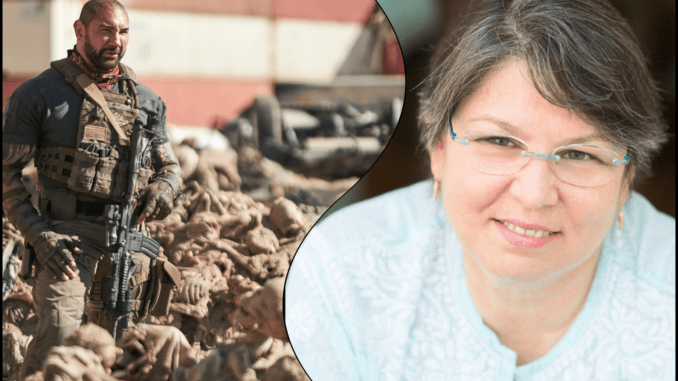
By Peter Tonguette
For picture editor Dody Dorn, ACE, over-the-top gore, splatter effects, and general movie mayhem do not usually add up to a good time at the movies.
“Anybody who knows me personally knows that I am the one who’s hiding their head under their jacket when those kinds of scenes happen when I’m watching a movie in a theater,” said Dorn, the Academy Award-nominated editor of Christopher Nolan’s “Memento” (2000). Among her many other credits are Ridley Scott’s “Kingdom of Heaven” (2005), Baz Luhrmann’s “Australia” (2008), co-edited with Michael McCusker, ACE, and David Ayer’s “Fury” (2014), co-edited with Jay Cassidy, ACE.
For her first collaboration with director Zack Snyder, however, Dorn was faced with cutting a picture that might have inspired some of those turn-away-from-the-screen moments. Snyder’s “Army of the Dead,” which Netflix will release in theaters and via streaming on Friday, merges two seemingly irreconcilable genres: the zombie movie and the heist movie. Written by Snyder, Shay Hatten, and Joby Harold, the wild, sometimes anarchic film has at its center a mercenary named Scott Ward (Dave Bautista), who, in a zombie-riddled future Las Vegas, is tapped to walk off with millions stowed away in a casino. A large supporting cast also includes Ella Purnell as Scott’s daughter, Kate; Matthias Schweighofer as the safecracker Dieter; and Tig Notaro as the helicopter pilot Marianne.
In Snyder’s telling of the post-apocalyptic story, there is gore galore, but Dorn was surprised to find she didn’t mind editing those scenes — in fact, she really enjoyed them.
“I have never cut anything with zombies,” she said. “And I have to admit that, even the gory parts, I get so much delight out of them because they are so over-the-top.”
She added: “Putting it together, it was really fun — just fun from the beginning to the end.”
In fact, “Army of the Dead” awakened some fond cinematic memories for Dorn, who, before her career as a sound editor kicked off in the late 1970s, was a movie buff with a real appreciation for sometimes-humorous horror or science fiction movies, including Richard Fleischer’s “Soylent Green” (1973) and John Landis’s “An American Werewolf in London” (1981) — the latter of which is given a tip of the hat at the start of Snyder’s film.
“That list was pretty big in an earlier portion of my life,” said Dorn, who also serves on MPEG’s Board of Directors. “But then, later on, as I got more and more entrenched in being a cinephile and loving cinema, I started to err in a different direction.”
With its allusions to cities under zombie quarantine, “Army of the Dead” presages the coronavirus pandemic, but the film itself was conceived long before the pandemic emerged. Location shooting commenced in the summer of 2019 in Albuquerque, New Mexico, and Atlantic City, New Jersey. Postproduction then began in Glendale. Although Dorn had not worked with Snyder previously, she felt that she was on the director’s wavelength in part because he served as his own cinematographer on the film — and, in between takes, provided something of an on-camera roadmap for the editor.
“He’s not just the DP,” Dorn said. “He operates the camera, so you can hear him talking to people and moving around.” She noted that Snyder, like many directors in the digital world, does not always cut between takes, so his instructions for cast and crew could be heard in dailies. “I can tell what he’s doing and why, because he talks out loud while he’s doing it,” Dorn said. “I watch everything, I listen to everything, I listen to off-camera reads, and I put together everything the best that I can, as a naïve viewer.”
For Dorn, the process of discovering a director’s intentions is more fruitful than having those intentions spelled out. “If I were being guided very specifically by a director saying, ‘Use this take, this take, or that line, that line,’ I think that you miss out on this other fresh viewpoint from somebody who wasn’t there who just has a reaction like a first-time viewer does in a movie theater or watching it streaming,” Dorn said.
And, because Snyder shot so much footage in such a creative manner, Dorn never had to submit a list of requested pickup shots — a first for her in her career. “He got everything. I’ve never not had a pickup list,” she said. “This [time], I had no pickup list.” For the scene in which Dieter enters the safe room, Dorn thought that an insert of a keycard slipping through a lock would be nice, but she thought twice about requesting it. “I thought, ‘You know, I’m getting the story without it,’” she said. “I had the sound effect, and I could see his hand movement and everything. I just didn’t have the tidy little insert.” But, lo and behold, the shot showed up anyway.
“I didn’t ask for it,” she said. “He felt the same thing.”
While working on the film, Dorn became something of a guru of gore — able to decide when to linger on a special effect and when to cut away from it. For example, in the opening to the film, a car wreck sidelines a caravan of military vehicles. In the ensuing pileup, a zombie named Zeus is released from the back of one of the military vehicles. When two soldiers tussle with Zeus, Dorn had a choice: to linger on the gore or to cut away quickly.
In the climax of the confrontation, Zeus begins ripping off the jaw of one of the soldiers, an act seen in greater detail, without quick cutting, in the original assembly of the scene. “I cut to a side angle where he completes pulling the jaw off, and his tongue lolls out of the side of his face,” Dorn said. “And we decided, ‘You know, we’ve just gone too far.’ So I took it out.” Making that change, however, caused Dorn to rethink other elements of the scene, which she had originally played in something closer to real time. –“Once I took the completion of the jaw rip-off and the lolling tongue, I had tightened up those two, three, four shots before it,” she said. “The moment became more that kind of traditional scary model, and it was the right thing to do.”
“Army of the Dead” runs 148 minutes, a typically lengthy running time for director Snyder. “I usually offer to any director at some point along the way, whether it be before the director’s cut period starts or halfway through: ‘I can bring this down. Do you want me to bring it down?’” Dorn said, but she did not have a taker in Snyder, who wanted to start long and then whittle down. “He’s just pleased to see that he got everything, and then he’s not at all precious,” she said. “Big chunks of the movie kind of went out immediately.”
Part of the art of crafting the film was balancing fright scenes with humorous interludes, without settling for too long into either mode. “That, to me, is a really fun moviegoing experience because it keeps you on your toes,” Dorn said. “You don’t just relax into your seat and go, ‘OK, I’m going to be scared for two hours.’ It’s a little bit of a shock to the system, which I think was also part of Zack’s intention.”
Dorn and Snyder continued their work together in person until March of 2020, when, sensing the looming pandemic, post-production supervisor Andrea Wertheim ordered remote systems for the team. “She saw it coming,” Dorn said. “She was probably one of the first in town to order remote systems, so by the time Monday, March 16, rolled around, those were being delivered to our homes, guest rooms, or offices.” By that time, a director’s cut had been completed, and although the preview process had to be scrapped, work continued from Dorn and Snyder’s respective homes. “Because we had already had those six months working together in person, it was very easy for us to transition to working remotely,” she said.
During a lull in post-production on “Army of the Dead,” Dorn was brought in to work on “Zack Snyder’s Justice League,” the director’s reconstitution of his original conception of the superhero film. The project, also edited by David Brenner, ACE, and Carlos M. Castillon (also the first assistant editor of “Army of the Dead”), premiered on HBO Max in March. “So much of that reconstituting was done before I ever sat down,” said Dorn, who, with her more limited, targeted work on the director’s cut, alternated between both projects. “There were a lot of plates that had to be spun, VFX-wise, for ‘Justice League,’” she said. “Once we spun those plates, then I could go back on ‘Army of the Dead.’”
Between the two films, though, Dorn has received a real education in all things Zack Snyder.
“I would be delighted and honored if I had the opportunity to work with Zack again,” she said.






